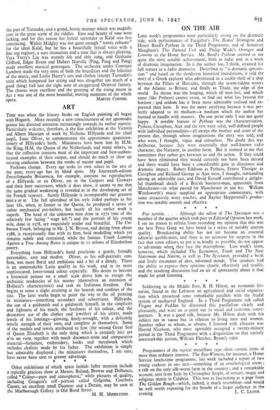ART
TIME was when the history books on English painting all began with Hogarth. More recently a new consciousness of our spasmodic genius has directed attention increasingly towards its earlier aspects. Particularly welcome, therefore, is the fine exhibition, at the Victoria and Albert Museum of work by Nicholas Hillyarde and his chief pupil, Isaac Oliver, to commemorate the approximate quatercen- tenary of Hillyarde's birth. Miniatures have been lent by H.M. the King, H.M. the-Queen of the Netherlands and many others, so that the collection contains most of the important and best-authen- ticated examples of their output, and should do much to clear up existing confusion between the works of master and pupil.
Fashions change. Every age seeks its own solace in the arts of the past; every age has its blind spots. My fourteenth-edition Encyclopaedia Britannica, for example, contains no reproduction of a Hillyarde or an Oliver, yet in the Coopers and Cosways and their later successors, which it does show, it seems to me that the same gradual weakening is revealed as in the developing art of the French tapestry. Surely Hillyarde is incomparably our greatest imin.a.ufst. 1 he full splendour of his style faded perhaps in his later life, when, as limner to the Queen, he produced a series of rather mechanical pot-boilers, but nearly all his earlier work is superb. The head of the unknown man done in 1572 (one of the relatively few facing "stage left ") and the portrait of his young wife, done in 1578, are exquisitely tender and beautiful. The Un- known Youth, belonging to Mr. J. N. Bryson, and dating from about 1588, is exceptionally fine with its firm, bold modelling which yet remains subtle and restrained, while the famous Youth Leaning Against a Tree Among Roses is unique in its echoes of Elizabethan poetry.
Everything from Hillyarde's hand proclaims a gentle, friendly personality, easy and modest. Oliver, as his self-portraits con- firm, was more florid and ambitious and a bit of a dandy. There is an unmistakable Latin quality in his work, and in its more sophisticated, lower-toned colour especially. His desire to become a historical painter on a small scale drove him to escape the archaistic tendencies of his master (themselves an extension of Holbein's characteristics) and seek an Italianate freedom. One begins to sense a slight straining at the bounds and confines of the size. The later works begin to point the way to the oil painting in miniature—something secondary and subservient. Hillyarde, the son of a goldsmith and a goldsmith himself, in the simplicity and lightness of his touch, the freshness of his colour, and the decorative use of the clothes and jewellery of his sitters made jewels of his limnings—glowing, finely-wrought, with a delicately tensile strength of their own, and complete in themselves. Some of the medals and jewels attributed to him (the second Great Seal of Queen Elizabeth is the only thing which is certainly his) are also on view, together with much documen ation and comparative material—furniture, embroidery, books and metalwork which includes chalices made by his father. The exhibition is simply but admirably displayed ; the miniatures themselves, I am sure, have never been seen to greater advantage.
* *. *
Other exhibitions of which space forbids fuller mention include a typically gracious show at Messrs. Roland, Browse and Delbanco, called "Colour—pure and atmospheric," while pictures of quality, including Gauguin's self - portrait called Golgotha, Courbets, Corots, an excellent small Daumier and a Derain, may be seen at the Marlborough Gallery in Old Bond Street.
M. H. MIDDLETON.


































 Previous page
Previous page